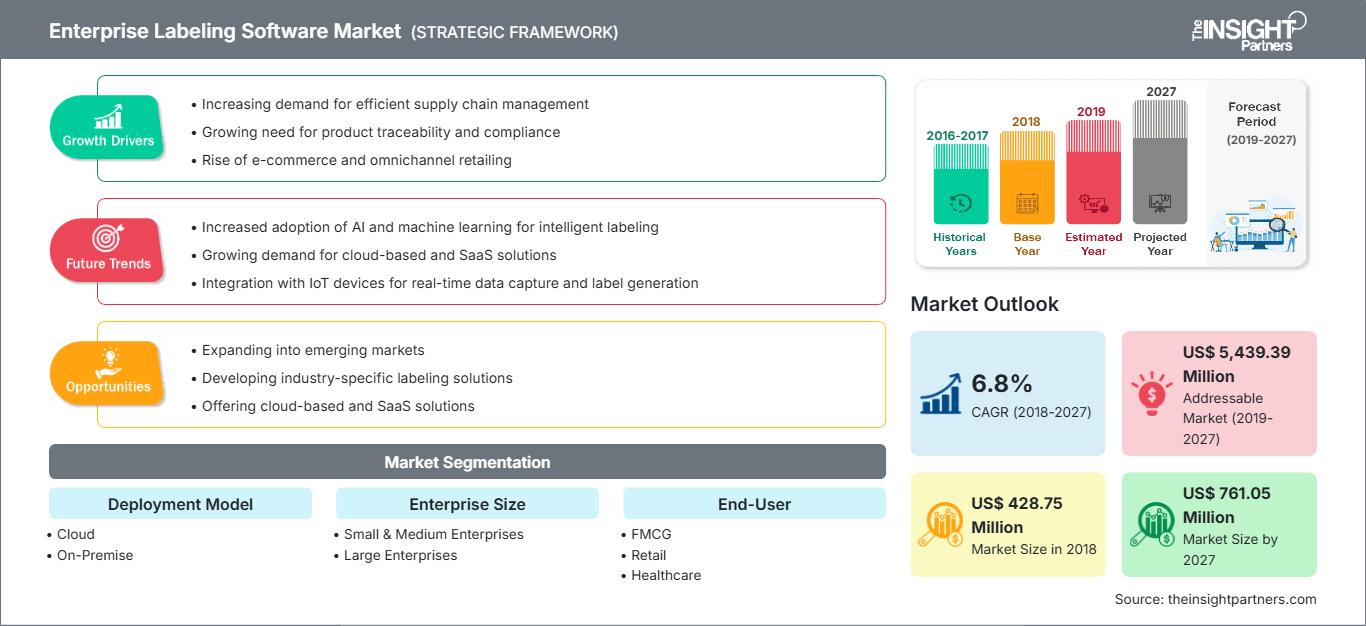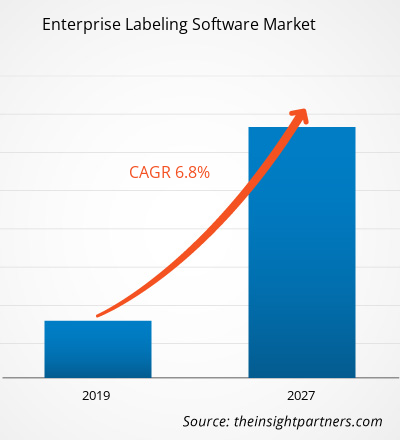2024년 시장 규모는 4억 8,231만 달러였으며, 2031년에는 7억 9,995만 달러에 이를 것으로 예상됩니다. 2025년부터 2031년까지 연평균 성장률(CAGR)이 7.8%에 이를 것으로 추산됩니다.
엔터프라이즈 라벨링 소프트웨어 시장 분석
여러 요인이 기업용 라벨링 소프트웨어 시장을 역동적으로 형성합니다. 공급망의 복잡성 증가와 엄격한 규제 요구는 기업들이 자동화 라벨링 솔루션을 도입하도록 유도합니다. 맞춤 설정, 통합 기능, 그리고 사용자 친화적인 인터페이스는 경쟁이 치열한 시장에서 공급업체들이 직면한 핵심 차별화 요소입니다. 해결해야 할 주요 과제는 다양한 산업별 요구 사항을 충족하고 기존 시스템의 호환성을 관리하는 방법입니다. 또한, 클라우드 도입은 원격 액세스와 확장 가능한 구축을 가능하게 하므로 시장에 영향을 미치지만, 구매 결정은 데이터 보안 문제에 큰 영향을 받습니다. 라벨링 소프트웨어 공급업체와 하드웨어 제조업체 간의 파트너십은 가치 제안의 매력을 높이는 통합 솔루션을 제공합니다. 실시간 데이터 분석 및 라벨 추적성에 대한 고객 요구는 지속적인 혁신을 촉진하고 있습니다.
엔터프라이즈 라벨링 소프트웨어 시장 개요
기업용 라벨링 소프트웨어 시장은 물류, 의료, 소매, 제조 등 다양한 산업의 프로세스를 간소화하는 확장성이 뛰어난 자동화 솔루션을 제공합니다. 이러한 소프트웨어는 현대 기업의 초석이며, 기업이 라벨의 디지털 제작, 인쇄 및 관리를 통해 정확성, 적합성 및 생산성을 유지할 수 있도록 지원합니다. 기업용 라벨링 소프트웨어 시장은 제조, 물류, 소매, 의료 등 다양한 산업의 프로세스를 조정하는 확장 가능하고 자동화된 솔루션을 제공합니다. 이러한 소프트웨어 솔루션은 기업이 라벨을 디지털 방식으로 제작, 인쇄 및 관리할 수 있도록 지원하여 정확성, 규정 준수 및 효율성을 유지하는 데 도움을 줍니다. 추적성, 규정 준수 및 효과적인 제품 정보 관리에 대한 수요가 증가함에 따라 기업들은 인적 오류를 줄이고 운영 워크플로를 개선하기 위해 라벨링 소프트웨어를 점점 더 많이 도입하고 있습니다. ERP 및 공급망 관리 시스템과의 통합은 이러한 도입을 촉진하고 있습니다.
이 보고서의 일부 또는 국가 수준 분석, Excel 데이터 팩을 포함하여 모든 보고서에 대한 사용자 정의를 무료로 받을 수 있으며, 스타트업 및 대학을 위한 훌륭한 혜택과 할인도 이용할 수 있습니다.
엔터프라이즈 라벨링 소프트웨어 시장: 전략적 통찰력

- 이 보고서의 주요 시장 동향을 알아보세요.이 무료 샘플에는 시장 동향부터 추정치 및 예측까지 다양한 데이터 분석이 포함됩니다.
엔터프라이즈 라벨링 소프트웨어 시장 동인 및 기회
시장 동인:
- 규정 준수: 엄격한 규정에 따라 제품 안전과 추적성을 보장하기 위해 정확하고 표준화된 라벨링이 필요합니다.
- 공급망의 복잡성: 글로벌 공급망이 확대됨에 따라 가시성을 유지하고 오류를 줄이기 위해 효율적인 라벨 관리가 요구됩니다.
- 디지털 혁신: 기업들은 수동 라벨링을 대체하고 운영 효율성을 개선하기 위해 자동화 솔루션을 도입하고 있습니다.
시장 기회:
- AI와 머신 러닝 통합: AI를 통합하면 라벨 정확도를 높이고 라벨링 프로세스에서 오류 감지를 자동화할 수 있습니다.
- 신흥 시장으로의 확장: 신흥 경제권에서 산업화가 확대됨에 따라 라벨링 솔루션에 대한 새로운 고객 기반이 생겨나고 있습니다.
- IoT 연결: 라벨링 소프트웨어를 IoT 장치에 연결하면 실시간 모니터링과 보다 스마트한 공급망 관리가 가능합니다.
엔터프라이즈 라벨링 소프트웨어 시장 보고서 세분화 분석
기업용 라벨링 소프트웨어 시장은 다음과 같이 세분화됩니다.
제공함으로써:
- 소프트웨어: 정밀도에 대한 필요성과 라벨링 절차의 자동화가 커지면서 라벨의 디자인, 관리, 인쇄를 쉽게 사용할 수 있는 고급 소프트웨어 솔루션에 대한 수요가 증가하고 있습니다.
- 서비스: 복잡한 방식으로 소프트웨어를 배포하고 통합하려는 기업에서는 이제 소프트웨어의 최대 가치를 얻기 위해 사용자 지정, 구현 및 지원을 제공할 수 있는 전문 서비스 제공업체를 찾고 있습니다.
배치별:
- 클라우드: 클라우드 기반 라벨링 소프트웨어가 성장하는 주요 이유 중 하나는 기업이 확장 가능하고 원격으로 접근 가능하며 초기 비용이 낮은 솔루션을 사용할 수 있는 기회를 제공하기 때문입니다.
- 온프레미스: 엄격한 데이터 보안 및 규정 준수 요구 사항을 충족해야 하는 기업은 여전히 온프레미스 방식을 선호하는 경향이 있습니다. 이를 통해 라벨링 시스템 및 기타 기밀 정보에 대한 완벽한 통제력을 유지할 수 있습니다.
최종 사용자별:
- FMCG
- 소매
- 헬스케어
- 창고 및 물류
- 자동차
- 조작
- 기타
기업 규모별:
- 중소기업(SME)
- 대기업
지리별:
- 북아메리카
- 유럽
- 아시아 태평양
- 라틴 아메리카
- 중동 및 아프리카
아시아 태평양 지역은 급격한 디지털 변혁과 진화된 공급망으로 인해 글로벌 기업용 라벨링 소프트웨어 시장에서 주요 지분을 보유한 지역입니다.
엔터프라이즈 라벨링 소프트웨어 시장 지역별 통찰력
The Insight Partners의 분석가들은 예측 기간 동안 엔터프라이즈 라벨링 소프트웨어 시장에 영향을 미치는 지역별 동향과 요인을 면밀히 분석했습니다. 이 섹션에서는 북미, 유럽, 아시아 태평양, 중동 및 아프리카, 그리고 중남미 지역의 엔터프라이즈 라벨링 소프트웨어 시장 부문 및 지역별 현황도 살펴봅니다.
엔터프라이즈 라벨링 소프트웨어 시장 보고서 범위
| 보고서 속성 | 세부 |
|---|---|
| 2024년 시장 규모 | 4억 8,241만 달러 |
| 2031년까지 시장 규모 | 7억 9,995만 달러 |
| 글로벌 CAGR(2025~2031년) | 7.8% |
| 역사적 데이터 | 2021-2023 |
| 예측 기간 | 2025-2031 |
| 다루는 세그먼트 | 제공함으로써
|
| 포함된 지역 및 국가 | 북아메리카
|
| 시장 선도 기업 및 주요 회사 프로필 |
|
엔터프라이즈 라벨링 소프트웨어 시장 참여자 밀도: 비즈니스 역학에 미치는 영향 이해
기업용 라벨링 소프트웨어 시장은 소비자 선호도 변화, 기술 발전, 그리고 제품 이점에 대한 인식 제고 등의 요인으로 인한 최종 사용자 수요 증가에 힘입어 빠르게 성장하고 있습니다. 수요가 증가함에 따라 기업들은 제품 및 서비스 확장, 소비자 니즈 충족을 위한 혁신, 그리고 새로운 트렌드를 적극 활용하며 시장 성장을 더욱 가속화하고 있습니다.

- 엔터프라이즈 라벨링 소프트웨어 시장의 주요 기업 개요를 알아보세요
지역별 엔터프라이즈 라벨링 소프트웨어 시장 점유율 분석
아시아 태평양 지역은 향후 몇 년 동안 가장 빠른 성장세를 보일 것으로 예상됩니다. 라틴 아메리카, 중동, 아프리카의 신흥 시장 또한 기업용 라벨링 소프트웨어 공급업체들이 사업을 확장할 수 있는 수많은 미개척 기회를 제공합니다.
기업용 라벨링 소프트웨어 시장은 지역마다 성장 속도가 다릅니다. 아래는 지역별 시장 점유율과 동향을 요약한 것입니다.
1. 북미
- 시장 점유율: 초기 기술 도입 및 주요 기업의 존재로 인해 선두를 달리고 있습니다.
- 주요 동인:
- 규정 준수 및 추적성에 대한 높은 수요
- 고급 디지털 전환 이니셔티브
- 클라우드 기반 솔루션의 강력한 채택
- 추세: 더욱 스마트한 라벨링 시스템을 위한 IoT 및 AI와의 통합 증가
2. 유럽
- 시장 점유율: 엄격한 규제 환경과 산업 다양성으로 인해 상당한 수준
- 주요 동인:
- 엄격한 라벨링 규정(예: REACH, GDPR) 준수
- 지속 가능성과 친환경 라벨링에 대한 관심 증가
- 다국어 및 맞춤형 라벨링에 대한 높은 수요
- 추세: 향상된 데이터 보안 및 현지 규정 준수를 위한 온프레미스 솔루션으로의 전환
3. 아시아 태평양
- 시장 점유율: 제조 및 소매 부문 확장으로 빠르게 성장
- 주요 동인:
- 산업화와 도시화로 수요가 급증하고 있습니다.
- 클라우드 및 모바일 라벨링 솔루션 도입 증가
- 글로벌 수출에서 공급망 가시성에 대한 필요성 증가
- 트렌드: 신흥 시장 및 중소기업으로의 라벨링 소프트웨어 확장
4. 남미 및 중미
- 시장 점유율: 소매 및 물류 산업의 관심 증가로 시장이 발전하고 있습니다.
- 주요 동인:
- 공급망 추적성 및 규정 준수 개선 필요성
- 확장 가능한 클라우드 솔루션 도입으로 비즈니스 확장 지원
- 가격에 민감한 시장에서 비용 효율적인 라벨링 솔루션에 집중
- 추세: 지역 공급업체와 글로벌 소프트웨어 공급업체 간의 파트너십 확대
5. 중동 및 아프리카
- 시장 점유율: 인프라 개발로 인한 성장 잠재력을 갖춘 신흥 시장
- 주요 동인:
- 성장하는 물류 및 제조 부문
- 운영 비효율성을 줄이기 위한 자동화 솔루션에 대한 수요
- 디지털 전환을 위한 정부 이니셔티브 확대
- 추세: 비용 효율성을 위한 클라우드 기반 배포의 점진적 도입
엔터프라이즈 라벨링 소프트웨어 시장 참여자 밀도: 비즈니스 역학에 미치는 영향 이해
높은 시장 밀도와 경쟁
기업용 라벨링 소프트웨어 시장은 치열한 경쟁이 벌어지고 있으며, 로프트웨어(Loftware Inc), 시걸 소프트웨어(Seagull Software, LLC), 제브라 테크놀로지스(Zebra Technologies Corp) 등 유수의 글로벌 기업들이 시장을 선도하고 있습니다. 여러 지역 및 틈새 시장 제조업체들도 사업 영역을 확대하면서 다양한 지역에서 경쟁이 심화되고 있습니다.
이러한 높은 수준의 경쟁으로 인해 기업은 다음과 같은 서비스를 제공하여 두각을 나타내야 합니다.
- 고도로 사용자 정의 가능하고 업계별 맞춤형 라벨링 솔루션
- 원활한 통합 기능
- 강력한 지원 및 서비스 제공
기회와 전략적 움직임
- 다양한 분야에서 클라우드 컴퓨팅과 디지털 전환 활동이 확대됨에 따라 기업용 라벨링 소프트웨어 시장이 확대될 가능성이 있습니다.
- IoT, AI, 고급 분석 기술과 라벨링 솔루션을 결합하면 보다 지능적인 공급망 관리가 가능해지고, 예측 가능한 방식으로 규정 준수를 모니터링할 수 있습니다.
- 특히 아시아 태평양과 중동 지역에서 새로운 시장이 성장함에 따라, 쉽게 확장 가능하고 적응성이 뛰어난 라벨링 솔루션에 대한 필요성이 커지고 있습니다.
- 제약, 식음료, 물류 등 산업의 특정 요구 사항에 맞춰 소프트웨어를 개발하면 변화하는 요구 사항을 충족하고 맞춤형 시장 세그먼트를 창출할 수 있습니다.
엔터프라이즈 라벨링 소프트웨어 시장에서 운영되는 주요 회사는 다음과 같습니다.
- 테크린스 코퍼레이션 SAS
- 유로소프트 플러스
- 이노베이텀 주식회사
- 로프트웨어 주식회사
- 제브라 테크놀로지스 주식회사
- 에스코그래픽스 BV
- 칼리크 유한회사
- 시걸 소프트웨어, LLC.
- 주식회사 아스트로노바
- 카르타고 소프트웨어 GmbH
참고: 위에 나열된 회사는 특정 순서에 따라 순위가 매겨지지 않았습니다.
연구 과정에서 분석된 다른 회사:
- 오룩스 주식회사
- 크리스탈라이트 소프트웨어
- CYBRA 주식회사
- 데이터 시스템즈 인터내셔널(DSI)
- 디디
- 에스코 그래픽스 BV
- 프레이르 소프트웨어 서비스
- 린 시스템즈 유한회사
- OPAL Associates Holding AG
- PSI 시스템즈 주식회사
- RF 스마트
- TEC IT 데이터 처리
- 타로 시스템즈 주식회사
- Wasp 바코드 기술
- 암텍 소프트웨어
엔터프라이즈 라벨링 소프트웨어 시장 뉴스 및 최근 개발
- BarTender와 Mojix, 추적성 혁신을 위한 전략적 파트너십 발표 2024년 9월, BarTender와 Mojix는 추적성 혁신을 목표로 전략적 파트너십을 발표했습니다. 양사는 더욱 지능적인 의사 결정과 운영 효율성 향상을 위한 탁월한 투명성을 제공하는 엔드투엔드 공급망 솔루션에 집중할 예정입니다.
- 바코드 및 RFID 추적 솔루션 분야의 선두주자인 CYBRA가 Acumatica와 전략적 파트너십을 체결했습니다. 2025년 1월, 바코드 및 RFID 추적 솔루션 분야의 선두주자인 CYBRA는 중소기업의 비즈니스 운영을 간소화하도록 설계된 최고의 클라우드 기반 ERP 소프트웨어 공급업체인 Acumatica와 전략적 파트너십을 체결했습니다. 이번 협력을 통해 Acumatica 사용자는 정밀 라벨 인쇄 및 실시간 RFID 추적을 위한 강력한 새로운 옵션을 제공받게 되며, 이를 통해 기업은 운영을 최적화하고 비효율성을 제거할 수 있습니다.
엔터프라이즈 라벨링 소프트웨어 시장 보고서 범위 및 제공물
"엔터프라이즈 라벨링 소프트웨어 시장 규모 및 예측(2021~2031)" 보고서는 아래 영역을 포괄하여 시장에 대한 자세한 분석을 제공합니다.
- 범위에 포함된 모든 주요 시장 부문에 대한 글로벌, 지역 및 국가 수준의 엔터프라이즈 라벨링 소프트웨어 시장 규모 및 예측
- 기업용 라벨링 소프트웨어 시장 동향 및 동인, 제약, 주요 기회와 같은 시장 역학
- 자세한 PEST 및 SWOT 분석
- 주요 시장 동향, 글로벌 및 지역 프레임워크, 주요 업체, 규정 및 최근 시장 개발 사항을 다루는 엔터프라이즈 라벨링 소프트웨어 시장 분석
- 시장 집중도, 히트맵 분석, 주요 업체 및 엔터프라이즈 라벨링 소프트웨어 시장의 최근 개발 사항을 다루는 산업 환경 및 경쟁 분석
- 자세한 회사 프로필
- 과거 분석(2년), 기준 연도, CAGR을 포함한 예측(7년)
- PEST 및 SWOT 분석
- 시장 규모 가치/거래량 - 글로벌, 지역, 국가
- 산업 및 경쟁 환경
- Excel 데이터세트
최근 보고서
관련 보고서
사용 후기
구매 이유
- 정보에 기반한 의사 결정
- 시장 역학 이해
- 경쟁 분석
- 고객 인사이트
- 시장 예측
- 위험 완화
- 전략 기획
- 투자 타당성 분석
- 신흥 시장 파악
- 마케팅 전략 강화
- 운영 효율성 향상
- 규제 동향에 발맞춰 대응






















 무료 샘플 받기 - 엔터프라이즈 라벨링 소프트웨어 시장
무료 샘플 받기 - 엔터프라이즈 라벨링 소프트웨어 시장